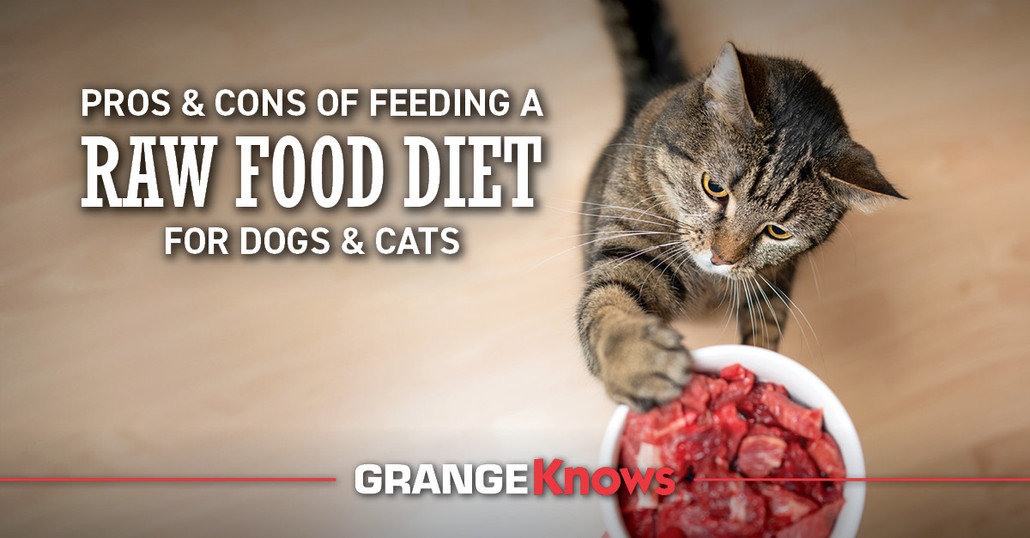
Pros and Cons of Feeding a Raw Food Diet for Dogs and Cats
Posted by Grange Co-op on 21st Nov 2023
Feeding our beloved dogs and cats is a topic that garners much attention and debate. Pet parents and veterinarians often have strong opinions about how to nourish our four-legged family members. One approach that has gained popularity in recent years is the raw food diet for dogs and cats. Advocates argue that it offers superior digestibility, enhanced nutrition, and fewer processed ingredients. However, it's not without its downsides, mainly due to the risk of bacterial transmission. In this blog, we will delve into the pros and cons of feeding a raw food diet to your pets and explore a safer alternative in freeze-dried treats and pet food.
What Is a Raw Food Diet for Pets?
A raw food diet for pets, often referred to as a "BARF" (Biologically Appropriate Raw Food) diet, consists of uncooked, unprocessed ingredients. It typically includes raw meat, bones, organs, and occasionally vegetables and fruits. This diet aims to mimic the diet of their wild ancestors, and proponents claim that it offers various benefits.
The Pros of a Raw Food Diet for Dogs and Cats
- Enhanced Nutrient Profile: Raw food diet for dogs and cats are often praised for their nutrient density. They typically contain more natural vitamins and minerals than commercially processed pet foods.
- Improved Digestibility: Raw dog and cat food is often easier to digest for pets as it lacks the fillers and additives in some commercial pet foods. It can lead to less bloating, firmer stools, and fewer digestive issues.
- Reduced Allergies: Some pet owners have reported a decrease in allergies and skin conditions in their pets when switching to a raw diet. This could be due to the elimination of common allergens found in commercial pet foods.
- Healthier Coat and Skin: The improved quality of nutrients in a raw diet can contribute to shinier coats and healthier skin in dogs and cats, making them look and feel their best.
- Potential for Weight Management: Raw diets allow for better portion control and can be customized to suit your pet's specific needs, making it easier to manage their weight.
- Better Dental Health: Chewing on raw bones can help clean your pet's teeth naturally, reducing the risk of dental problems.
The Cons of a Raw Food Diet for Dogs and Cats
- Risk of Bacterial Contamination: Raw meat and other ingredients used in a raw diet can be contaminated with harmful bacteria, such as Salmonella and E. coli, which can pose health risks to pets and humans. Handling and storing raw meat safely is crucial but not foolproof.
- Nutritional Imbalance: Ensuring a balanced diet with all necessary nutrients is challenging when feeding raw food, as it requires careful planning and supervision. Inadequate nutrition can lead to deficiencies or imbalances in your pet's diet.
- Expense and Inconvenience: A raw food diet can be costly and time-consuming. It often involves purchasing premium ingredients and meticulously portioning meals to meet your pet's nutritional needs.
- Pet Allergies: Just like humans, pets can have allergies to specific foods. Identifying and eliminating allergens in a raw diet can be challenging and might require consulting a veterinarian.
- Lack of Scientific Consensus: While some pet owners swear by raw diets, scientific evidence on their long-term benefits and risks remains inconclusive.
A Safer Alternative: Freeze-Dried Pet Food
Freeze-dried pet food is a process that preserves food by freezing it and then removing most of its moisture. This method maintains the nutritional integrity of the ingredients while extending the shelf life. Freeze-dried pet food is often considered a middle ground between raw and traditional kibble.
 Advantages of Freeze-Dried Pet Food
Advantages of Freeze-Dried Pet Food
While the raw food diet offers potential benefits, the associated risks and challenges have led many pet parents to seek alternatives. Freeze-dried treats and pet food provide a convenient solution to enjoy the advantages of raw nutrition without the dangers. Here's why:
- Long Shelf Life: Freeze-dried pet food has a long shelf life, making it convenient for storage and use.
- Safety: Freeze-drying is a process that effectively eliminates harmful bacteria, ensuring the safety of the food. This makes it a safer option for pets and pet owners concerned about bacterial contamination.
- Nutrition: Freeze-dried pet food retains much of the nutritional value of raw ingredients. This means your pets can still benefit from high-quality proteins and essential nutrients without the risk of imbalances.
- Convenience: Freeze-dried pet food and treats are easy to store, measure, and serve. They require no refrigeration, making them a convenient option for busy pet parents.
- Reduced Environmental Impact: Some freeze-dried pet food brands focus on sustainable sourcing and environmentally friendly packaging, helping address concerns about the ecological impact of pet diets.
- Variety: Freeze-dried pet food is available in various flavors and types, including treats, which can add diversity to your pet's diet and keep them interested.
- Great Taste: Pets love the taste of freeze-dried food, making mealtime a more enjoyable experience.
Get Your Pet Food from Grange Co-op
When it comes to pet nutrition, it's essential to weigh the options carefully and consult with your veterinarian to make the best choice for your cat or dog. Whether you choose to embrace the raw food diet or opt for freeze-dried alternatives, your pets' health and happiness should always be the top priority.
For high-quality dog and cat food, consider exploring the selection at Grange Co-op. We offer a wide range of options to cater to your pets' unique nutritional needs, ensuring their diet is both delicious and nutritious. Make informed choices that benefit your pets, making them healthier, happier companions.
